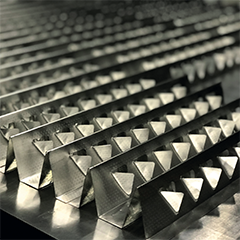Overcoming module degradation
CEO & Founder, Simon Meijer, gave PES a thought-provoking introduction to COOLBACK. Their aim is to keep modules cooler, adding strength with less materials, whilst keeping an eye on their carbon footprint. What could be better than an R&D oriented company to lead the way in curbing module degradation?
PES: Thank you for taking some time out to talk to us Simon, it’s lovely to have you with us. I’m sure many of our readers will be familiar with COOLBACK already, but it would be good to begin with a brief introduction to the company and the system.
Simon Meijer: It’s great to have the opportunity. I started the company with the goal of improving module technology. We are a Dutch R&D-based company and we designed a new frame/backsheet solution that cools PV modules. After the introduction of the product, COOLBACK, we followed up by developing related products for PV manufacturing, including a completely automated assembly station.
In addition to the cooling solutions, COOLBACK strengthens modules and reduces degradation. This is enhanced by our custom designed and patented mounting clamps that we also sell and produce.
PES: Module degradation is obviously a big issue in terms of lifespan and performance, what do you see as the biggest causes of that degradation, are temperature and humidity mostly to blame?
SM: Indeed! Temperature changes and humidity significantly affect degradation, particularly with the backsheet, but the impacts can also be seen in the cells and other materials.
PES: Are certain countries and climates more prone to such degradation than others?
SM: The more extreme the climate, the quicker degradation accelerates. High radiation input obviously is the best for production, but it also has a detrimental effect on degradation.
Floating installations bring new challenges, as well. The proximity to water, sometimes even salt water, create bigger temperature differences between the laminate and backside of modules, resulting in additional degradation.
Overcoming module degradation
CEO & Founder, Simon Meijer, gave PES a thought-provoking introduction to COOLBACK. Their aim is to keep modules cooler, adding strength with less materials, whilst keeping an eye on their carbon footprint. What could be better than an R&D oriented company to lead the way in curbing module degradation?
PES: Thank you for taking some time out to talk to us Simon, it’s lovely to have you with us. I’m sure many of our readers will be familiar with COOLBACK already, but it would be good to begin with a brief introduction to the company and the system.
Simon Meijer: It’s great to have the opportunity. I started the company with the goal of improving module technology. We are a Dutch R&D-based company and we designed a new frame/backsheet solution that cools PV modules. After the introduction of the product, COOLBACK, we followed up by developing related products for PV manufacturing, including a completely automated assembly station.
In addition to the cooling solutions, COOLBACK strengthens modules and reduces degradation. This is enhanced by our custom designed and patented mounting clamps that we also sell and produce.
PES: Module degradation is obviously a big issue in terms of lifespan and performance, what do you see as the biggest causes of that degradation, are temperature and humidity mostly to blame?
SM: Indeed! Temperature changes and humidity significantly affect degradation, particularly with the backsheet, but the impacts can also be seen in the cells and other materials.
PES: Are certain countries and climates more prone to such degradation than others?
SM: The more extreme the climate, the quicker degradation accelerates. High radiation input obviously is the best for production, but it also has a detrimental effect on degradation.
Floating installations bring new challenges, as well. The proximity to water, sometimes even salt water, create bigger temperature differences between the laminate and backside of modules, resulting in additional degradation.
To read the full content,
please download the PDF below.



























